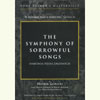Górecki Symphony No 3, 'Symphony of Sorrowful Songs'
Heartfelt music, desperate images – but can they be combined successfully?
View record and artist detailsRecord and Artist Details
Composer or Director: Henryk Górecki
Genre:
DVD
Label: Tony Palmer
Magazine Review Date: 9/2007
Media Format: Digital Versatile Disc
Media Runtime: 53
Mastering:
Stereo
DDD
Catalogue Number: TPDVD102

Tracks:
| Composition | Artist Credit |
|---|---|
| Symphony No. 3, 'Symphony of Sorrowful Songs' |
Henryk Górecki, Composer
David Zinman, Conductor Dawn Upshaw, Soprano Henryk Górecki, Composer London Sinfonietta |
Author: Mike Ashman
This is a difficult release to quantify, especially when offered for repeated home viewing. Some contemporary images of the industrial heart of Katowice, Górecki’s birthplace, introduce the composer and his struggles against the old Polish Communist regime. We then hear and see a performance of his Third Symphony by the artists who made the 1992 Nonesuch recording that, after extensive radio play, achieved huge sales. In interview Górecki explains how this music was his way of expressing the “great sorrow of the war, the rotten times under communism, our life today, the starving…”. Palmer illustrates these themes quite literally, intercutting the performance of the music with the continuing interview with the composer, film of his visit to the site of the Auschwitz-Birkenau concentration camps, and documentary footage of the camps’ wartime carnage, of starving and wounded children in contemporary Africa and the Balkans, and of German fascists today.
It is, of course, done with the best of intentions and complete professionalism, with the editing in of the film material surely intended to amplify rather than replace (or distract from) the symphony. But Górecki wrote a symphony that is complete in itself. Any amplifying of its meaning has already been done by the “sorrowful songs” themselves (their texts are by the victims of Nazi oppression in Poland). Does Górecki’s work benefit from such literal illustration, or does Palmer’s selection of images need this music? I could imagine a more abstract illustration of the music working, or a division of this film between documentary and performance. Run together, the two media seem to cancel each other out.
It is, of course, done with the best of intentions and complete professionalism, with the editing in of the film material surely intended to amplify rather than replace (or distract from) the symphony. But Górecki wrote a symphony that is complete in itself. Any amplifying of its meaning has already been done by the “sorrowful songs” themselves (their texts are by the victims of Nazi oppression in Poland). Does Górecki’s work benefit from such literal illustration, or does Palmer’s selection of images need this music? I could imagine a more abstract illustration of the music working, or a division of this film between documentary and performance. Run together, the two media seem to cancel each other out.
Discover the world's largest classical music catalogue with Presto Music.

Gramophone Digital Club
- Digital Edition
- Digital Archive
- Reviews Database
- Full website access
From £8.75 / month
Subscribe
Gramophone Full Club
- Print Edition
- Digital Edition
- Digital Archive
- Reviews Database
- Full website access
From £11.00 / month
Subscribe
If you are a library, university or other organisation that would be interested in an institutional subscription to Gramophone please click here for further information.




